Mexico › Veracruz
Updated: March 3, 2022
See Also
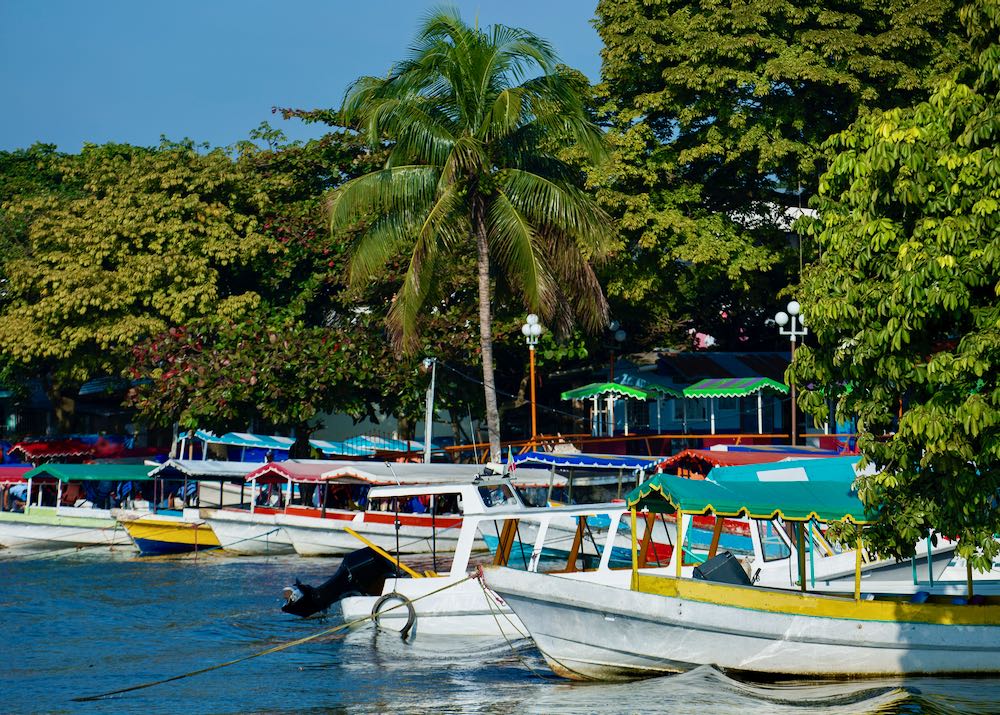
Veracruz is a major port and popular resort city on the eastern, Gulf Coast of Mexico, and one of our absolute favorite places to go in the country. Veracruz is best known for its rich history, tropical setting, charming old town, raucous nightlife, and the biggest aquarium in Latin America.
Frequently Asked Questions about Veracruz
Where is Veracruz?
Veracruz is a port on the Gulf of Mexico and the largest city in the Mexican state of Veracruz. It lies around 90 km southeast of the state capital Xalapa, 420 km east of Mexico City, and 270 km east of Puebla. Non-stop flights to Veracruz take just 55 minutes from Mexico City, 1 hour 35 minutes from Monterrey, 2 hours 15 minutes from Houston, and 3 hours 20 minutes from Tijuana.
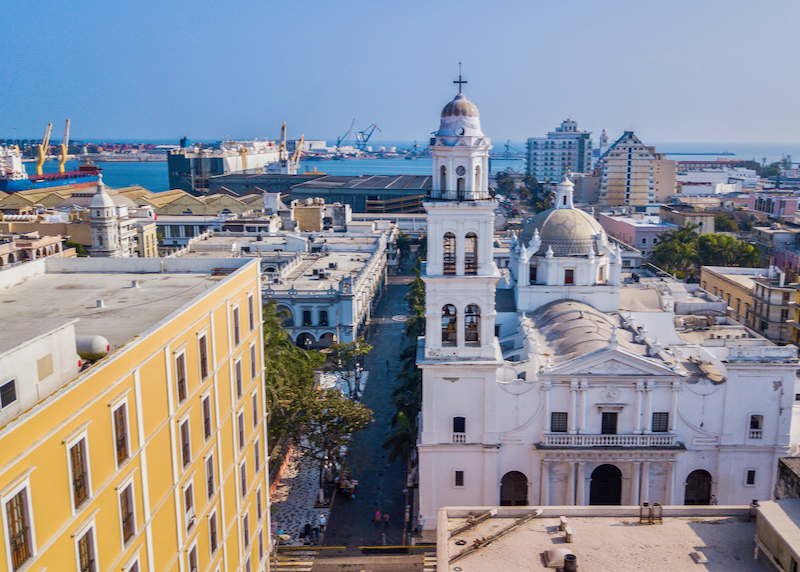
The historic downtown area of the port city of Heroica.
How big is Veracruz?
Veracruz has a greater metro population of just over 700,000. The city and busiest resort area stretches some 20km north to south along the Gulf of Mexico, from the port to the Jamapa River.
What is the history of Veracruz?
Veracruz (officially “Heroica Veracruz”), is one of the most historic cities in Mexico. Once part of the Aztec Empire, the city was the first to be founded by the Spanish in Mexico, just after Hernán Cortés’ fateful arrival in 1519. Cortés and his conquistadors waded ashore and made camp here, but the city was relocated up the coast a couple of times before settling on its current location in 1589. Veracruz subsequently became a crucial port city, the main link between Mexico and Spain – as a consequence the English, Dutch, and French frequently attacked its shipping throughout the sixteenth and seventeenth centuries. In the Mexican War of Independence, Veracruz was the last part of the country held by the Spanish, and in the Mexican–American War (1846–48), US troops occupied the city and marched on to capture the capital. In 1861 the French invaded Mexico through the port of Veracruz, and in 1914 US troops returned to occupy the city during the Mexican Revolution. Since then, the city has flourished as Mexico’s biggest port and a key petroleum-refining hub (there are major oil fields offshore).
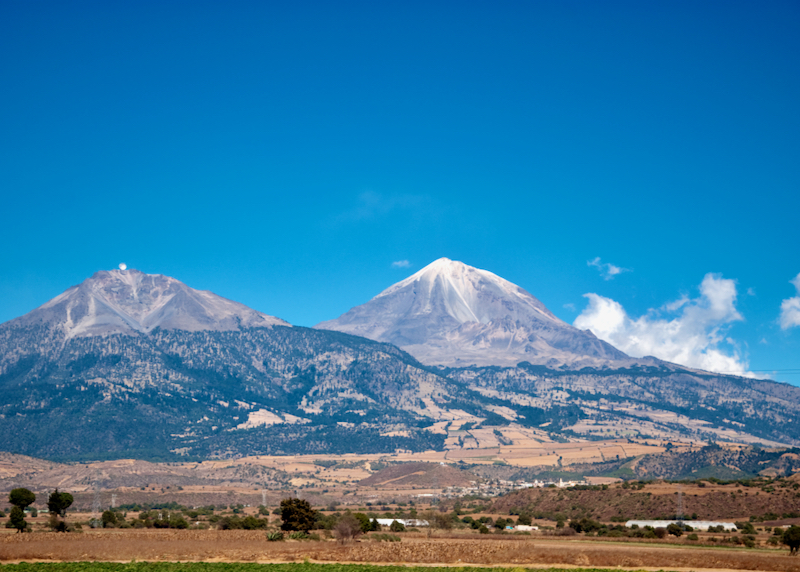
‘Pico de Orizaba’ is the tallest mountain in Mexico and 3rd tallest in North America.
How do I get to Veracruz?
Veracruz is connected to the US by three weekly non-stop flights from Houston on United, but its airport otherwise serves Mexican domestic destinations only; Cancún, Guadalajara, Mexico City, and Tijuana among them. All other flights from Canada, the US, and Europe route through Houston or Mexico City.
Veracruz airport is about 10km south of the city; it’s simple and convenient to take a taxi from here into the center (around 300 pesos; pay in advance at the taxi desk in the terminal).
Within Mexico, first-class long-distance buses are an economical and comfortable alternative to flying – buses to Veracruz from Puebla (3 hours) and Mexico City (5 hours 30 minutes) operate hourly. Veracruz bus station is about 3km from the city center. Arriving there it’s best to take a taxi – these follow a fixed-rate system, with the current rates displayed at the exit. Buy a ticket from the dedicated booth before getting in (around 45 to 50 pesos).
Can I use Uber in Veracruz?
Currently Uber does not operate in Veracruz.
Can I drive to Veracruz?
Driving down to Veracruz from the US border is relatively straightforward – the main highways are good, and virtually empty outside the towns. However, the Mexican border states of Nuevo León and Tamaulipas have been affected by drug cartel violence – driving at night is definitely a bad idea. Check the latest travel advisories at travel.state.gov or ask the hotel. Drivers also need a Mexican “Temporary Importation of Vehicle Permit”.
From Brownsville, Texas the drive is around 590 miles (950 km) and takes around 13 hours non-stop.
Renting a car is much easier to do on the Mexican side of the border, as taking US rental vehicles into Mexico comes with all sorts of restrictions.
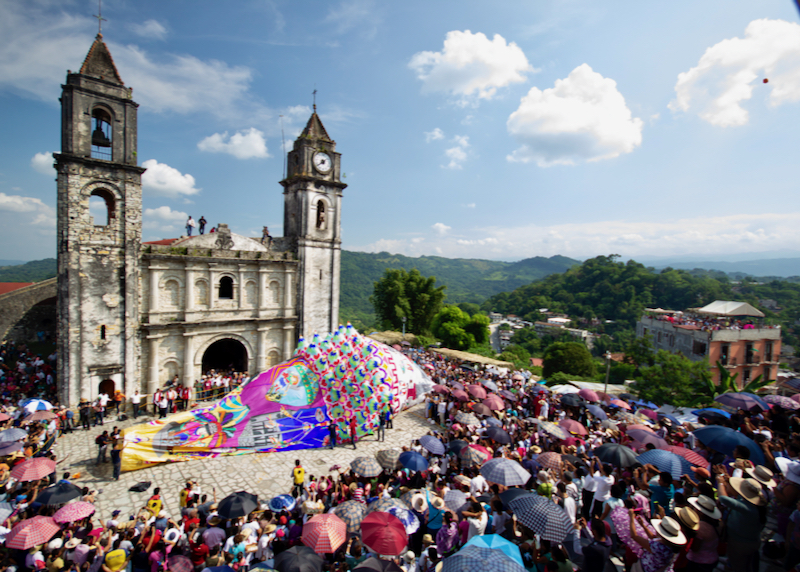
The paper balloon festival in front of the Church of San Miguel Arcangel.
Do I need a car in Veracruz?
Most of the historic center of Veracruz can be explored on foot; for the beaches and attractions further afield it’s easy and cheap to take a taxi or a bus (navigating the congested roads of Veracruz can be a real headache in any case). Taxis are easy to hail on the street (hotels will also call them) – always fix the price in advance before getting in (there are no meters). The minimum fare is 35 pesos, but trips in the center will rarely top 50 pesos. Buses for the beaches (labeled “Boca del Río”, “Playas” or “Mocambo”) run along Zaragoza Street close to the zócalo (main square). Local buses charge a flat fare of 9 pesos (expected to increase by a few pesos in the coming year).
When is the best time to go to Veracruz?
During the dry season, from November to May – Veracruz is a tropical city but temperatures at this time are more comfortable and less humid. To get the best hotel rates and to avoid the crowds, skip Veracruz during Christmas, Easter, or the Veracruz Carnival (Feb/March), when the city is mobbed by domestic tourists. The hot, humid wet season runs from June to October – hotel rates can be cheaper, but exploring the city is miserable at this time.
What are the main resort areas in Veracruz?
The historic city center of Veracruz (“Centro Histórico”) fronts the port and marina, and most of the resort hotels lie along the beaches further south, linked by Bulevar María Ávila Camacho. The closest beaches to the center are Playa Villa del Mar and neighboring Playa Hornos and Playa Martí: it’s not great for swimming here (the water is not clean), but there is plenty of seafood and boat trips are offered to Cancuncito and the Isla de Sacrificios, just offshore. Further south, Costa de Oro is home to several major resorts, though the beaches here are also fairly scrappy. Playa Mocambo is much better, a kilometer south, with beach bars, a small water park, and lots of decent hotels. At the end of the strip, 3.5 km south of Mocambo, lies Boca del Río at the mouth of the River Jamapa. There are more long, grey-sand beaches here, but the main attractions are the town’s riverfront seafood restaurants and boat trips upstream into the jungle.
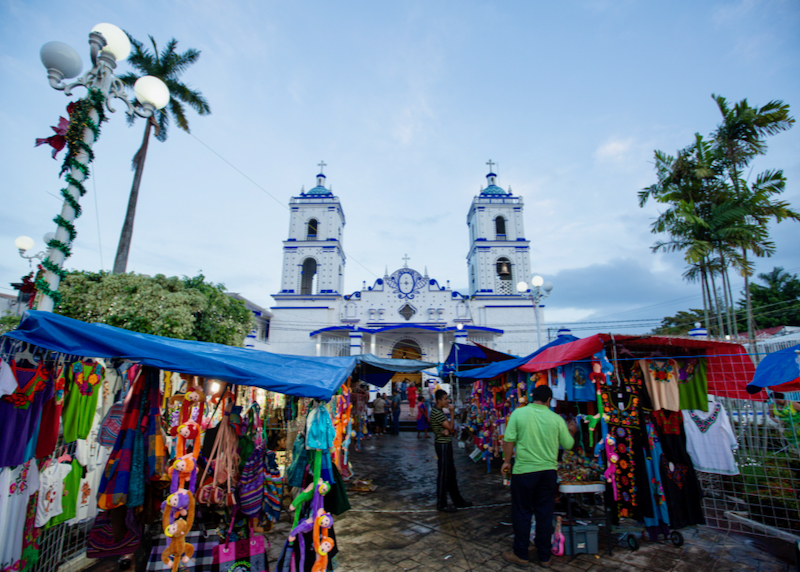
Market on the plaza in front of the Basílica de Nuestra Señora del Carmen in Catemoc.
What are the best beaches in Veracruz?
Our favorite beach in Veracruz is Playa Mocambo – it’s by far the nicest stretch of sand and is the best for swimming. Playa Martí is closer to the center and is a fun spot to watch local beach volleyball and soccer matches. Playa Hornos is the best place for watersports.
Where should I stay in Veracruz?
We would recommend somewhere in the Old Center of Veracruz, the “Centro Histórico”, to make the most of the nightlife, sights, best restaurants and attractions. While it’s true that the hotels here tend to be more old-fashioned, the resort hotels along the beaches are quite a long way from the action – and Veracruz isn’t known for its beaches in any case (they are not Mexico’s best). Staying in the city center it’s relatively easy to take a taxi or bus out to the beaches for the day. On the other hand, those that prefer a few hours of sightseeing followed by every afternoon on the beach may want to check out the resorts in the coastal “hotel zone”.
In the city center, we like the Hotel Emporio, which combines a central location with excellent amenities and a pool overlooking the harbor. The Hotel Veracruz Centro Histórico and Hotel Baluarte are other excellent choices in the center. Hotel Indigo Boca del Rio is a chic, contemporary option close to Playa Mocambo, as is the Collection O Hotel Mocambo, a beautifully renovated hotel from 1932.
What are the best things to do in Veracruz?
Veracruz has an energy and cultural identity unlike any other Mexican resort city.
The old heart of the city is its main plaza, known as the Zócalo. Dominated by the city’s beautiful cathedral, the Zócalo is the perfect place to sip local mint juleps and listen to marimba bands (based around a giant wooden xylophone), as well as mariachi and norteño music. Similarly lively in the evenings, the malecón (harbourfront promenade) features street vendors, buskers, and “dancing” fountains. The city’s biggest conventional attraction is the Acuario de Veracruz, the huge aquarium, though there are also plenty of historic sights. Get oriented at the Museo de la Ciudad, a museum that chronicles the history of the city, and the Museo Histórico Naval, which charts Mexican naval history from the Mesoamerican period to the modern-day. It’s also possible to visit the city’s once-formidable Spanish fortifications: the 17th-century Baluarte de Santiago and the ruined Castillo de San Juan de Ulúa, complete with creepy dungeon.
Though the beaches of Veracruz (see above) are not the best in Mexico, they can make for a relaxing day in the sun. Snorkeling and diving trips out to the nearby islands are also fun: Cancuncito is a tiny sandbank in crystal-clear waters, while the Isla de Sacrificios is off-limits but surrounded by enticing snorkeling sites, and La Blanquilla, Isla Verde, and Anegada de Adentro are all reef sites just 20 minutes ride from the beach. Recommended operators include Mundo Submarino and Scubaver. Monkey Fish is another excellent operator that can arrange kayaking, paddleboarding, sandboarding, and snorkeling. Armonia Rafting can arrange whitewater rafting in nearby Jalcomulco.
What are the restaurants like in Veracruz?
Veracruz is well-known throughout Mexico for its cuisine, with its signature dish, Huachinango a la Veracruzana (red snapper Veracruz-style), available almost everywhere. Other local specialties include pulpo a la marinera (octopus), arroz a la tumbada (local seafood rice, a bit like paella), empanadas de camarón (shrimp empanadas), and jaiba, a large Gulf crab. The local coffee, fruits, and vanilla are also worth sampling, and all the seafood is fabulous.
Another pleasure in Veracruz is hanging out in its old colonial cafés – always lively and ringing with the sound of spoons clinking against glasses (the traditional way to call for a refill). Gran Café del Portal (Independencia 1187) and Café de la Parroquia (Gómez Farías 34) are the two most famous and our favorite spots to enjoy breakfast. For a treat, we like the contemporary Mexican food at Restaurante Fussion (Av. 1º de Mayo 632).
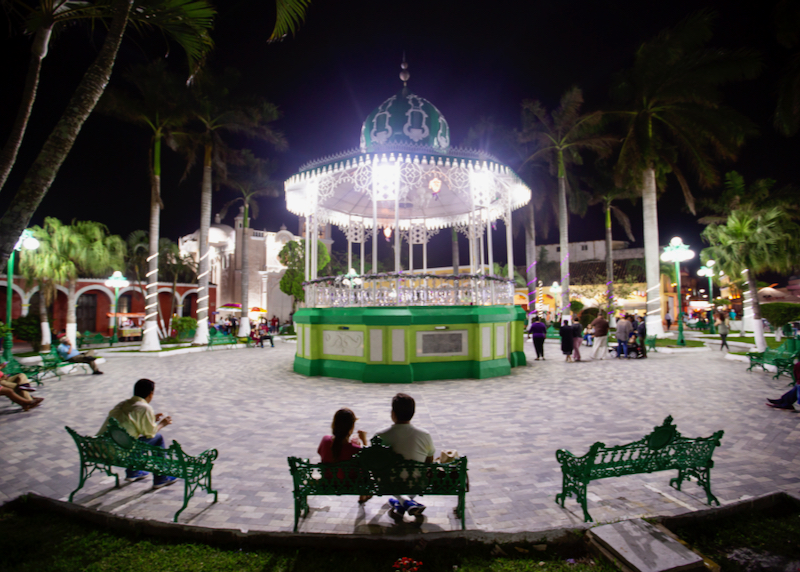
Enjoying an evening on the plaza in Tlacotalpan.
What currency is used in Veracruz?
The Mexican peso (often prefixed with a “$” sign) is the currency of Mexico and Veracruz. Most major shops and restaurants in Veracruz accept credit cards, but it is a good idea to have some peso cash on hand for bus/taxi trips, museum entry, and small purchases like bottled water and snacks. ATMs are easy to find in Veracruz around the junction of Independencia and Benito Juárez.
Is Veracruz expensive?
Hotels in Veracruz are reasonably priced, and food and drink is a good value. All beaches are open to the public and free to visit, buses and taxis are cheap, and budget Airbnb deals are also a viable option.
Is Veracruz safe?
Veracruz has generally avoided the drug violence that has affected other parts of Mexico. Take the usual precautions, especially at night, and keep valuables in room safes. Theft of personal items from beaches does happen – never leave anything of value unattended, even on seemingly empty stretches of sand.
Read More
- Cancun – Best Hotels
- Cancun – Family Hotels
- Isla Mujeres – Best Hotels
- Isla Mujeres – Family Hotels
- Los Cabos – Travel Guide
- Los Cabos – Best Hotels
- Los Cabos – Family Hotels
- Mazatlan – Best Hotels
- Mazatlan – Family Hotels
- Playa del Carmen – Best Hotels
- Playa del Carmen – Family Hotels
- Puerto Vallarta – Best Hotels
- Puerto Vallarta – Family Hotels
- Punta de Mita – Best Hotels
- Sayulita – Best Hotels
- Tulum – Best Hotels
- Tulum – Family Hotels